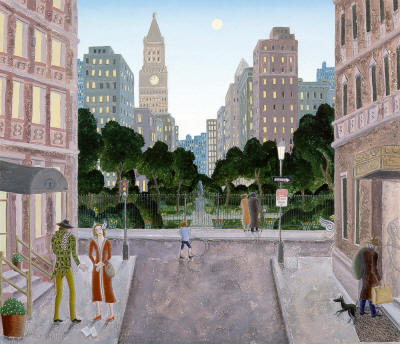Remembering The Disappeared
Taking a mini-break from the hectic environment that is completing my research paper, for the first time in many years, I finally got to semi-participate in the annual Museum Mile Festival. Yeah! Although it rained and I quickly realized that my transportation opportunities were limited by being up in the early 100's mark of the city's street numbers, I didn't realize upon getting there that all of 5th Avenue was closed down for the event. So, walking in the pouring rain in unfamiliar territory was a bit of a let down to the festivities.
What I really wanted to see was an exhibition at El Museo del Barrio on The Disappeared (Los Desaparecidos), which was nearing the end of its run.
An explanation of the term:
"To disappear was newly defined during the twentieth century military dictatorships in Latin America. 'Disappear' evolved into a transitive verb describing those considered threats to the State who were kidnapped, tortured, and killed by their own military, especially in the 1970s in Argentina, Brazil, Chile, and Uruguay."
My interest in this subject came about accidentally, several years ago, after coming across the book I Remember Julia at the library.
Even if you are not well versed in the stories of The Disappeared, this exhibit pretty much spelled things out. That such a horrifying period of history could produce such impacting art, is in a word - amazing. To read the stories about The Disappeared is one thing, to see artist interpretations is another matter all together. Many of the artists involved were either members of the resistance, survivors themselves, or had known those who had been abducted. Their art depicts the absolute fear, violence, personal loss, mental confusion and torture of this hellish period of time. Although the entire exhibit moved me beyond all imaginable means possible, some of the following really struck a resounding chord inside of me.
*Arturo Duclos' untitled piece of the flag of Chile made up of 75 human femurs screwed together.
*Marcelo Brodsky's Buena Memoria (Good Memory), showing his class photo and the reunion of any survivors afterwards. Some of the students in the portrait were victims of these regimes and vanished only a few years after graduating. An online website devoted to his work and this exhibit can be found here. Even more moving was in 1996, when the school held a ceremony to read off the names of all 98 disappeared students who had attended.
*In a work called "Urban Intervention in the City of Rosario", artist and former resistance fighter, Fernando Traverso, spray painted 350 live-sized images of bicycles throughout his hometown of Rosario, Argentina. The 350 represents the total number of citizens who vanished from the city. Traverso acted after midnight, or at noon when most residents were in their homes for the noon meal and subsequent siesta. The first evidence that someone had disappeared was their abandoned bicycle, a preferred method of transport for resistance workers. Traverso then "intervened" by painting the bicycles either at or near the spot of the abduction.
*Identidad, was a collaborative effort by many Argentinian artists to show one of the more serious aftermaths of this period, the missing children of the disappeared. They had been taken at birth and adopted into military families from those who opposed the government. Some abducted women were kept until their pregnancies came to term and murdered shortly after giving birth. By working with the Association of the Grandmothers of the Plaza de Mayo, the collective gathered photos of these women (and where possible, their partners), hung mirrors next to their portraits, and provided the possible birth month and year of the disappeared's children. The mirrors were for anyone who, having dubious feelings about their birth, might be able to see any resemblance to any of the women in the photos and be reunited with their birth mother's family. When Identidad opened in Buenos Aires, three people discovered their long-hidden identities.
I don't know if this exhibit will travel anywhere else in the future. Prior to its showing at El Museo del Barrio, it debuted at the North Dakota Museum of Art. But, if this ever arrives in an area near you, I suggest you not miss out.
I don't like linking things from the NY Times. Only because their links expire quickly and one is then forced to pay for the article. But, they had a really good feature on this exhibit.



No comments:
Post a Comment